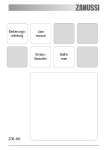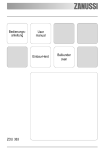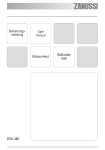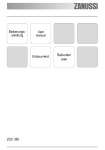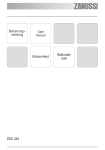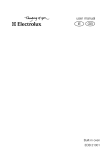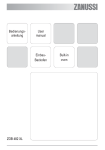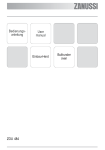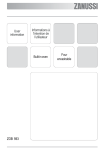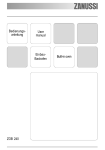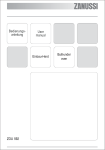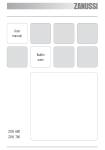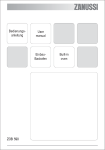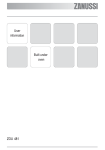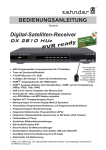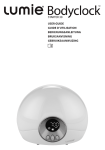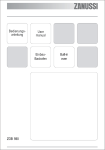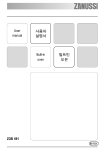Download Zanussi ZOU 461 User's Manual
Transcript
Bedienungsanleitung User manual Einbau-Herd ZOU 461 Built-under oven Deutsch Inhaltsverzeichnis Warnungen und wichtige Sicherheitshinweise --------- 3 Gerätebeschreibung ----------------------------------------- 4 Bedienung ----------------------------------------------------- 5 Vor der erstmaligen Benutzung --------------------------- 6 Elektronische Zeitschaltuhr -------------------------------- 7 Benutzung des Backofens --------------------------------- 10 Tabellen Backen und Braten ------------------------------- 13 Reinigung und Wartung ------------------------------------- 14 Störungen - Was tun? --------------------------------------- 17 Technische Daten -------------------------------------------- 18 Anweisungen für den Installateur ------------------------- 18 Einbau-Anweisungen --------------------------------------- 19 Kundendienst ------------------------------------------------- 20 Anleitung zur Gebrauchsanweisung Sicherheitshinweise ) Schritt-für-Schritt-Anleitung Praktische Tipps Umweltinformationen 2 Warnungen und wichtige Sicherheitshinweise Heben Sie auf jeden Fall die mit diesem Gerät gelieferte Gebrauchsanweisung auf. Sollte das Gerät an Dritte abgegeben oder verkauft werden, oder falls Sie das Gerät bei einem Umzug in der alten Wohnung lassen, ist es von größter Wichtigkeit, dass der/die neue Nutzer(in) über diese Gebrauchsanweisung und die Hinweise verfügen kann. Diese Hinweise dienen der Sicherheit des Nutzers und seiner Mitbewohner. Lesen Sie sie also aufmerksam, bevor Sie das Gerät anschließen und/oder in Gebrauch nehmen. Aufstellung • Die Installation muss von fachkundigem Personal • • • vorgenommen werden, unter Beachtung der bestehenden Vorschriften. Die einzelnen Installationsarbeiten sind unter den Hinweisen für den Installateur beschrieben. Lassen Sie die Installation und den Anschluß von einem Fachmann, gemäß den ihm dank seiner Fachkenntnis bekannten Richtlinien ausführen. Auch gegebenenfalls auf Grund der Installation erforderliche Modifikationen an der Stromversorgung haben durch einen Fachmann zu erfolgen. Dieser Backofen wurde je nach Ausführung als Einzelgerät oder als Kombinationsgerät mit Elektroplatte für den Anschluß an jeweils 1,2 oder 3 Phasen (oder Gruppen) an 230 V hergestellt. Der Anschluß an mehr Phasen ohne Nulleiter (400 V) führt zu Zerstörung des Ofens und der angeschlossenen Kochplatten. Betrieb • Dieser Backofen ist zur Zubereitung von Speisen • • • • • • gedacht; gebrauchen Sie ihn niemals zu Anderem. Beim Öffnen der Backofentür, während oder am Ende des Garens auf den Heißluftstrom achten, der aus dem Backofen austritt. Beim Herdbetrieb mit erhöhter Vorsicht vorgehen. Durch die starke Hitze der Heizstäbe sind Rost und sonstige Teile sehr heiß. Falls Sie - aus welchen Gründen auch immer Alufolie zur Zubereitung von Speisen im Backofen verwenden sollten, lassen Sie diese nie in direkten Kontakt mit dem Boden des Backofens kommen. Gehen Sie bei der Reinigung des Backofens vorsichtig vor: sprühen Sie nie auf den Fettfilter (falls vorhanden), die Heizstäbe und den Thermostatfühler. Es ist gefährlich, Veränderungen jeglicher Art an diesem Gerät oder an seinen Eigenschaften vorzunehmen. Während des Back-, Brat- und Grillvorgangs werden das Backofenfenster und die übrigen Geräteteile heiß. Kinder sollten daher von dem Gerät ferngehalten werden. Bei Anschluss von Elektrogeräten an Steckdosen in Backofennähe ist darauf zu achten, dass Anschlussleitungen nicht mit heißen Kochstellen in Berührung kommen oder in der heißen Backofentür eingeklemmt werden. • Verwenden Sie immer Topfhandschuhe, um • • • • • feuerfeste heiße Schüsseln oder Töpfe aus dem Backofen zu nehmen. Eine regelmäßige Reinigung verhindert die Verschlechterung des Oberflächenmaterials. Schalten Sie vor der Reinigung des Backofens entweder den Strom ab, oder ziehen Sie den Netzstecker. Stellen Sie sicher, dass sich der der Backofen in der Position «AUS» befindet, wenn er nicht mehr benutzt wird. Das Gerät darf nicht mit einem Heißdampf- oder Dampfstrahlreiniger gereinigt werden. Benutzen Sie keine Scheuermittel oder scharfe Metallschaber. Sie können die Türscheiben verkratzen und dadurch zum Zerspringen der Scheiben führen. Personensicherheit • Dieses Gerät ist für den Gebrauch durch Erwachsene • • bestimmt. Es ist gefährlich, wenn Sie es Kindern zum Gebrauch oder Spiel überlassen. Halten Sie Kinder fern, solange der Backofen in Betrieb ist. Auch nachdem Sie den Backofen ausgeschaltet haben, bleibt die Tür noch lange heiß. Das Gerät darf von Kindern oder Personen, deren physische, sensorische oder geistige Fähigkeiten und deren Mangel an Erfahrung und Kenntnissen einen sicheren Gebrauch des Gerätes ausschließen, nur unter Aufsicht oder nach ausreichender Einweisung durch eine verantwortungsbewußte Person benutzt werden, die sicherstellt, dass sie sich der Gefahren des Gebrauchs bewusst sind. Kundendienst • Lassen Sie Überprüfungsarbeiten und/oder • Reparaturen vom Kundendienst des Herstellers oder von einem vom Hersteller autorisierten Kundendienst ausführen, und verwenden Sie nur OriginalErsatzteile. Versuchen Sie nicht, das Gerät bei Funktionsstörungen oder Schäden selbst zu reparieren. Durch Reparaturen seitens ungeschulter Personen können Schäden oder Verletzungen hervorgerufen werden. 3 Umweltinformationen Das Symbol • Ein Gerät, das nicht funktioniert, muß vom Stromnetz getrennt werden, damit es nicht versehentlich benützt wird. Ziehen Sie bei ausgedienten Geräten den Netzstecker aus der Steckdose und machen Sie Netzschlußleitung sowie Stecker unbrauchbar. Sie verhindern damit, daß ein Mißbrauch mit den Geräten getrieben wird. • auf dem Gerät bzw. auf dem Verpackungsmaterial weist darauf hin, dass es nicht über den normalen Hausmüll entsorgt werden darf. Es muss stattdessen an eine Sammelstelle für das Recycling von elektrischen und elektronischen Geräten übergeben werden. Durch Ihren Beitrag zum korrekten Entsorgen dieses Produkts schützen Sie die Umwelt und die Gesundheit Ihrer Mitmenschen. Umwelt und Gesundheit werden durch falsches Entsorgen gefährdet. Weitere Informationen über das Recycling dieses Produkts erhalten Sie bei Ihrem Rathaus, der Müllabfuhr oder dem Geschäft, in dem Sie das Produkt gekauft haben. Gerätebeschreibung 2 3 4 5 6 7 8 9 10 1 11 12 13 14 15 1. 2. 3. 4. 5. 6. 7. 8. 9. 10. 11. 12. 13. 14. 15. Bedienblende Knebel für Kochstelle vorne links Knebel für Kochstelle hinten links Temperaturregler - Kontrollanzeige Temperaturregler Elektronische Zeitschaltuhr Backofenregler Betriebsanzeige Knebel für Kochstelle hinten rechts Knebel für Kochstelle vorne rechts Lüftungsschlitze für Kühlgebläse Grill Innenbeleuchtung Backofen-Ventilator Typenschild Zubehör Backblech Fettpfanne 4 Rost Bedienung Backofenregler 0 Der Backofen ist ausgeschaltet. Ober- und Unterhitze 0 Oberhitze Unterhitze Grill Umluft Auftauen Betriebsanzeige Die Betriebsanzeige leuchtet, wenn der Backofenregler eingestellt wird. Temperaturregler Drehen Sie den Temperaturregler gegen den Uhrzeigersinn, um Temperaturen zwischen 50°C and 250°C auszuwählen. Temperaturregler - Kontrollanzeige Diese Kontrollanzeige leuchtet, wenn der Temperaturregler gedreht wird. Die Anzeige leuchtet so lange, bis die gewünschte Temperatur erreicht ist. Sie schaltet sich dann zyklisch ein und aus und zeigt damit an, dass die Temperatur aufrecht erhalten wird. Bedienungsknebel für Kochmulde An der Schalterblende befinden sich die Schalt-Knebel für die vier Kochmulden-Heizelemente. Die Kochstellen werden mit einem 9-Takt-schalter geregelt, wovon die folgenden Arbeitsstufen benutzt werden können: 0 = AUS 1 = Minimum 9 = Maximum Zweikreis - Zuschaltung (siehe die Liste der Geräte im Kapitel "Technische Daten") Das Zuschalten beider Heizkreise erfolgt durch das Drehen des Kochzonenknebels von Stufe 9 auf Position “ ” (im Uhrzeigersinn); “Klick” ist hörbar. Beide Heizkreise sind jetzt gleichzeitig eingeschaltet. Anschließend wird die gewünschte Stufe eingestellt (Knebel gegen den Uhrzeigersinn drehen). Die Zubereitung von Speisen mit Öl oder Fett wie z.B. pommes frites, darf nicht ohne Aufsicht geschehen, da Öle und Fette bei überhitzung leicht entflammen können. 5 Sicherheits-Thermostat Kühlventilator Um gefährliche Überhitzung zu vermeiden (durch unsachgemäßen Gebrauch des Gerätes oder defekte Bestandteile), ist der Backofen mit einem SicherheitsThermostat ausgestattet, welcher die Stromversorgung unterbricht. Die Wiedereinschaltung erfolgt automatisch bei Temperaturabfall. Sollte der Sicherheits-Thermostat aufgrund unsachgemäßen Gebrauchs des Gerätes ansprechen, genügt es, nach der Abkühlung des Backofens die Fehlerursache zu beseitigen. Spricht dagegen der Thermostat wegen eines defekten Bauteiles an, so wenden Sie sich bitte an den Kundendienst. Der Kühlventilator kühlt den Backofen und das Bedienfeld. Der Ventilator springt automatisch an, wenn der Backofen einige Minuten in Betrieb ist. Warme Luft wird durch die Blende in der Nähe des Ofentürgriffs ausgeblasen. Nachdem der Backofen ausgeschaltet wurde, läuft der Ventilator möglicherweise noch weiter, um die Bedienelemente zu kühlen. Das ist normal. Wie lange der Ventilator weiterläuft, richtet sich danach, wie lange der Backofen in Betrieb war und welche Temperatur gewählt wurde. Bei niedrigeren Temperatureinstellungen schaltet sich der Ventilator möglicherweise gar nicht ein, oder er läuft nicht weiter, wenn der Backofen nur kurzzeitig in Betrieb war. Vor der erstmaligen Benutzung Entfernen Sie das gesamte Verpackungsmaterial innen und außen am Backofen, bevor Sie ihn in Betrieb nehmen. Vor dem erstmaligen Gebrauch sollte der Backofen einmal aufgeheizt werden, ohne dass sich Lebensmittel darin befinden. Dabei kann sich ein unangenehmer Geruch entwickeln. Das ist normal. Die Ursache sind Herstellungsrückstände. Stellen Sie sicher, dass der Raum gut belüftet ist. 1. Drehen Sie den Backofenregler auf Umluft . 2. Drehen Sie den Temperaturregler auf 250 °C. 3. Öffnen Sie zur Belüftung ein Fenster. 4. Lassen Sie den Backofen nun leer etwa 45 Minuten lang laufen. Wiederholen Sie den Vorgang mit der Funktion "Grill" für etwa 5-10 Minuten. Lassen Sie den Backofen anschließend abkühlen. Feuchten Sie dann ein weiches Tuch gut mit warmem Wasser und etwas mildem Spülmittel an, und reinigen Sie damit den Garraum. Reinigen Sie vor dem ersten Gebrauch auch die Zubehörteile gründlich. ) Fassen Sie zum Öffnen der Tür den Griff immer in der Mitte an. 6 Elektronische Zeitschaltuhr 4 1. Taste für die Funktionsauswahl 5 7 6 8 2. Taste „ “ 3. Taste „ “ 4. Anzeige 5. „Gardauer“- Kontrolllampe 6. „Garzeitende“- Kontrolllampe 2 1 3 Der Backofen funktioniert erst nach dem Einstellen der Uhrzeit. Der Backofen kann jedoch auch ohne Einstellen eines Programms betrieben werden. Bei Stromausfall werden dieDaten gelöscht und müssen neueingegeben werden.Wenn der Strom wiedervorhanden ist, blinken dieFunktionsleuchten und dieUhrzeit kann neue eingestelltwerden. 7. „Kurzzeit“ - Kontrolllampe 8. „Uhrzeit“- Kontrolllampe Einstellen der Uhrzeit Nachdem die Stromversorgung eingeschaltet wurde oder wenn ein Stromausfall aufgetreten ist, blinkt die Kontrolllampe „Uhrzeit“ auf dem Display. So stellen Sie die Uhrzeit ein: 1. Drücken Sie die Taste „ “ oder „ “. 2. Warten Sie anschließend 5 Sekunden: die Kontrolllampe „Uhrzeit“ erlischt, und auf dem Display wird die eingestellte Zeit angezeigt. Das Gerät ist nun betriebsbereit. So stellen Sie die Uhrzeit erneut ein: 1. Drücken Sie die Taste wiederholt, um die Funktion „Uhrzeit“ auszuwählen. Die entsprechende Kontrolllampe beginnt zu blinken. Gehen Sie dann wie oben beschrieben vor. Die Uhrzeit kann nur zurückgesetzt werden, wenn keine automatische Funktion (Gardauer oder ) eingestellt wurde. Garzeitende Gardauer Bei Wahl dieser Funktion wird der Backofen automatisch nach Ablauf einer programmierten Gardauer ausgeschaltet. Stellen Sie Lebensmittel in den Backofen, wählen Sie eine Garfunktion aus, und stellen Sie die gewünschte Gartemperatur ein. Drücken Sie die Taste wiederholt, um die Funktion „Gardauer“ auszuwählen. Die beginnt zu blinken. entsprechende Kontrolllampe 7 Gehen Sie dann wie folgt vor: So programmieren Sie die Gardauer: 1. Drücken Sie die Taste „ “ oder „ “. 2. Nachdem Sie die Einstellung vorgenommen haben, warten Sie 5 Sekunden: die Kontrolllampe „Gardauer“. leuchtet, und auf dem Display wird wieder die Uhrzeit angezeigt. 3. Wenn die programmierte Zeit abgelaufen ist, schaltet sich der Backofen automatisch aus. Ein akustisches Signal ertönt, und die Kontrolllampe blinkt. Drehen Sie den Backofenregler und den Temperaturregler auf Null. Der Signalton lässt sich durch Drücken einer beliebigen Taste abstellen. HINWEIS: Durch das Ausschalten des akustischen Signals wird der Backofen auf manuellen Betrieb zurückgesetzt. Wenn der Backofenregler und der Temperaturregler nicht auf Null gedreht werden, heizt sich der Backofen nun wieder auf. So löschen Sie eine programmierte Gardauer: 1. Drücken Sie die Taste wiederholt, um die Funktion „Gardauer“ auszuwählen. Die entsprechende Kontrolllampe blinkt, und auf dem Display wird die restliche Garzeit angezeigt. 2. Drücken Sie die Taste „ “ bis auf dem Display „0:00“ angezeigt wird. Nach 5 Sekunden erlischt die Kontrolllampe, und auf dem Display wird wieder die Uhrzeit angezeigt. Garzeitende Bei Wahl dieser Funktion wird der Backofen automatisch ausgeschaltet, wenn ein programmiertes Garzeitende ereicht ist. Stellen Sie Lebensmittel in den Backofen, wählen Sie eine Garfunktion aus, und stellen Sie die gewünschte Gartemperatur ein. Drücken Sie die Taste wiederholt, um die Funktion „Garzeitende“ auszuwählen. Die entsprechende Kontrolllampe beginnt zu blinken. Gehen Sie dann wie folgt vor: So programmieren Sie das Ende der Garzeit: 1. Drücken Sie die Taste „ “ oder „ ”. 2. Nachdem Sie die Einstellung vorgenommen haben, warten Sie 5 Sekunden: die Kontrolllampe „Garzeitende“ leuchtet, und auf dem Display wird wieder die Uhrzeit angezeigt. 3. Wenn die programmierte Zeit abgelaufen ist, schaltet sich der Backofen automatisch aus. Ein akustisches Signal ertönt, und die Kontrolllampe blinkt. Drehen Sie den Backofenregler und den Temperaturregler auf Null. Der Signalton lässt sich durch Drücken einer beliebigen Taste abstellen. HINWEIS: Durch das Ausschalten des akustischen Signals wird der Backofen auf manuellen Betrieb zurückgesetzt. Wenn der Backofenregler und der Temperaturregler nicht auf Null gedreht werden, heizt sich der Backofen nun wieder auf. 8 So löschen Sie ein programmiertes Garzeitende: 1. Drücken Sie die Taste wiederholt, um die Funktion „Garzeitende“ auszuwählen. Die entsprechende Kontrolllampe blinkt, und auf dem Display wird das programmierte Garzeitende angezeigt. 2. Drücken Sie die Taste „ “, bis die auf dem Display die Uhrzeit angezeigt wird. Es wird ein akustisches Signal ausgegeben, und die Kontrolllampe erlischt. Kombination von „Gardauer“ „Garzeitende“ und Die Funktionen „Gardauer“ und „Garzeitende“ können gleichzeitig verwendet werden, damit sich der Backofen zu einem späteren Zeitpunkt automatisch aus- und wieder einschaltet. 1. Legen Sie mithilfe der Funktion „Gardauer“ (nehmen Sie die in dem entsprechenden Kapitel erläuterten Einstellungen für die Gardauer vor) die Gardauer fest. Drücken Sie anschließend die Taste : die programmierte Einstellung wird auf dem Display angezeigt. 2. Legen Sie mithilfe der Funktion „Garzeitende“ (nehmen Sie die in dem entsprechenden Kapitel erläuterten Einstellungen für das Garzeitende vor) das Ende der Garzeit fest. Die entsprechenden Kontrolllampen leuchten, und auf dem Display wird die Uhrzeit angezeigt. Der Backofen schaltet sich gemäß der eingestellten Programme ein und aus. Kurzzeit Das Kurzzeitsignal ertönt am Ende eines eingestellten Zeitraums; der Backofen bleibt jedoch eingeschaltet, falls er gerade benutzt wird. So stellen Sie den Kurzzeitwecker ein: 1. Drücken Sie die Taste wiederholt, um die Funktion „Kurzzeit“ auszuwählen. Die entsprechende Kontrolllampe beginnt zu blinken. 2. Drücken Sie anschließend die Taste „ “ oder „ “ (längster Zeitraum: 2 Stunden, 30 Minuten). 3. Nachdem Sie die Einstellung vorgenommen haben, warten Sie 5 Sekunden. Die Kontrolllampe „Kurzzeit“ leuchtet. 4. Ist das Ende des eingestellten Zeitraums erreicht, beginnt die Kontrolllampe zu blinken, und ein akustisches Signal ertönt. Drücken Sie eine beliebige Taste, um den Signalton abzustellen. So schalten Sie den Kurzzeitwecker aus: 1. Drücken Sie die Taste wiederholt, um die Funktion „Kurzzeit“ auszuwählen. Die entsprechende Kontrolllampe blinkt, und auf dem Display wird die verbleibende Zeit angezeigt. 9 2. Drücken Sie die Taste „ “, bis auf dem Display „0:00“ angezeigt wird. Nach 5 Sekunden erlischt die Kontrolllampe, und auf dem Display wird wieder die Uhrzeit angezeigt. Ausschalten der Anzeige 1. Drücken Sie zwei der Programmtasten gleichzeitig, und halten Sie sie ca. 5 Sekunden lang gedrückt. Die Anzeige wird ausgeschaltet. 2. Um die Anzeige wieder einzuschalten, drücken Sie eine beliebige Taste. Die Anzeige kann nur dann ausgeschaltet werden, wenn keine anderen Funktionen programmiert wurden. Benutzung des Backofens Der Backofen wird mit einem exklusiven natürlichen Umluft- und Dampfsystem geliefert. Das Garen mit Dampf macht Ihre Speisen innen weich und außen knusprig. Die Gardauer und der Energieverbrauch werden dabei auch noch reduziert. Während des Backens kann Dampf entstehen, der beim Öffnen der Tür entweichen kann. Das ist normal. Stellen Sie sich daher nicht vor den Backofen, wenn Sie die Tür während des Backens öffnen, und lassen Sie nach dem Backvorgang den Ofen und Dampf abkühlen. Wichtig! - Legen Sie den Backofen nicht mit Alufolie aus, und stellen Sie kein Backblech usw. auf den Boden, da sonst das Backofen-Email durch den entstehenden Hitzestau beschädigt wird. Stellen Sie Pfannen und Töpfe, hitzebeständige Pfannen und Töpfe sowie Aluminiumbleche immer auf den Einschub, der in eine der Einschubschienen eingesetzt ist. Beim Erhitzen von Lebensmitteln wird Dampf erzeugt wie in einem Kessel. Wenn der Dampf mit dem Backofen-Türglas in Berührung kommt, kondensiert er und es entstehen Wassertröpfchen. Um Kondensation zu verringern, den leeren Backofen immer 10 Minuten vorheizen. Wir empfehlen Ihnen, die Wassertropfen nach jedem Garvorgang wegzuwischen. Die Backofentür muss beim Garen geschlossen sein. Gehen Sie beim Öffnen der Backofentür sorgfältig vor. Lassen Sie die Tür nicht „offen fallen“, sondern benutzen Sie den Türgriff, bis die Tür vollständig geöffnet ist. Der Backofen hat vier Einschubebenen. Die Positionen der Einschübe werden vom Boden des Backofens aus gezählt, wie in der Abbildung gezeigt. Die Einschübe müssen unbedigt richtig eingesetzt werden (siehe Abbildung). Stellen Sie Geschirr und Töpfe nicht direkt auf den Boden des Backofens. 10 Umluft - - - - Die Speisen werden mit Umluft gegart, die über ein Gebläse an der Ofenrückwand gleichmäßig im Backofen-Innenraum verteilt wird. Die Hitze erreicht schnell und gleichmäßig alle Ofenzonen. Das bedeutet, Sie können gleichzeitig unterschiedliche Speisen auf mehreren Ebenen backen, braten und dünsten. Umluftgaren beseitigt rasch die Feuchtigkeit; die trockene Ofenluft verhindert, dass die verschiedenen Aromen und Gerüche von einer Speise auf die anderen übertragen werden. Die Möglichkeit, auf mehreren Ebenen zu garen, bedeutet, dass Sie verschiedene Gerichte gleichzeitig und bis zu drei Kuchenformen oder Minipizzas für den Verzehr oder zum Einfrieren backen können. Natürlich können Sie den Backofen auch mit nur einem Einschub benutzen. In diesem Fall sollten Sie die unterste Schiene verwenden, sodass Sie den Backvorgang besser im Auge behalten können. Zusätzlich ist der Backofen besonders zum Sterilisieren von Eingemachtem, zum Kochen von -selbstgemachter Konfitüre und zum Trocknen von Pilzen und Obst geeignet. Grillen - - - Die meisten Lebensmittel sollten auf den Rost in der Grillpfanne gelegt werden, um ein Höchstmaß an Luftzirkulation zu ermöglichen und damit die Lebensmitteln nicht im Fett und ihrem eigenen Saft liegen. Fisch, Leber und Nieren können bei Bedarf auch direkt in die Grillpfanne gelegt werden. Die Lebensmittel sollten möglichst trocken sein, bevor sie gegrillt werden, um Spritzen zu vermeiden. Pinseln Sie mageres Fleisch oder Fisch leicht mit Öl oder geschmolzener Butter ein, damit das Grillgut beim Garen saftig bleibt. Gemüse als Beilage, wie zum Beispiel Tomaten und Pilze, können beim Grillen von Fleisch unter den Grillrost gelegt werden. Brot sollte auf der obersten Einschubleiste geröstet werden. Das Grillgut sollte von Zeit zu Zeit gewendet werden. Stufe vor, bevor Sie Steaks anbraten oder Brot toasten. Passen Sie die Hitze und die Einschubhöhe falls notwendig während des Grillvorgangs an. Während des Grillvorgangs funktionieren der Ventilator und die Kontrollanzeige für die Temperatur auf die gleiche Weise wie beim Betrieb mit Heiß-/Umluft. Unterhitze Diese Funktion ist besonders nützlich beim Blindbacken von Teig. Sie kann auch für Quiches oder Pasteten verwendet werden, damit gewährleistet ist, dass der Grundteig durchgebacken ist. Die Kontrolllampe des Temperaturreglers leuchtet so lange, bis die richtige Temperatur erreicht ist. Sie schaltet sich dann zyklisch ein und aus und zeigt damit an, dass die Temperatur aufrecht erhalten wird. Oberhitze Diese Funktion eignet sich zum Überbacken von fertigen Gerichten, zum Beispiel Lasagne oder überbackener Blumenkohl usw. Ober- und Unterhitze - - - Benutzung des Grills 1. Drehen Sie den Backofenregler, um den Backofen einzuschalten . 2. Drehen Sie den Temperaturregler auf die gewünschte Temperatur. 3. Wählen Sie die passende Einschubleiste für Grillpfanne und Rost, je nachdem, ob es sich um flaches oder dickeres Grillgut handelt. Je nachdem, wie schnell oder langsam die Lebensmittel gegrillt werden sollen, platzieren Sie das Grillgut näher am Grillelement oder weiter davon entfernt. Heizen Sie den Grill einige Minuten lang auf höchster - Auf der mittleren Einschubhöhe verteilt sich die Hitze am besten. Wenn die Unterseite von Speisen stärker gebräunt sein soll, verwenden Sie einfach eine niedrigere Einschubhöhe. Soll die Oberseite stärker gebräunt sein, setzen Sie den Einschub auf einer Position weiter oben ein. Das Material und die Verarbeitung der Backbleche und des Kochgeschirrs beeinflussen den Bräunungsgrad der Unterseite der Speisen. Emaillierte, dunkle, schwere oder unbeschichtete Formen und Küchengeräte ermöglichen eine stärkere Bräunung der Unterseite, während Formen aus Glas oder glänzendem Aluminium oder polierte Stahlbleche die Hitze reflektieren und daher nur eine geringe Bräunung der Unterseite zulassen. Stellen Sie die Gerichte immer in die Mitte des Einschubs, um eine gleichmäßige Bräunung zu erzielen. Stellen Sie die Gerichte auf Backbleche angemessener Größe, sodass Flüssigkeiten nicht auf den Backofenboden auslaufen können. Sie sparen so auch Reinigungsaufwand. Stellen Sie Gerichte, Dosen oder Backbleche nie direkt auf den Boden des Backofens, da dieser sehr heiß wird und Beschädigungen auftreten können. Bei dieser Einstellung wird die Hitze von Heizelementen oben und unten erzeugt. Sie benötigen daher nur eine einzige Einschubebene für den Garvorgang. Diese Einstellung eignet sich insbesondere für Gerichte, die zusätzlich von unten gebräunt werden müssen, wie zum Beispiel Quiches und Pasteten. Gratins, Lasagne und andere überbackene Gerichte, 11 die insbesondere von oben gebräunt werden müssen, lassen sich mit dieser Einstellung ebenfalls gut zubereiten. So verwenden Sie Ober- und Unterhitze: 1. Drehen Sie den Backofenregler auf die gewünschte . Funktion 2. Drehen Sie den Temperaturregler auf die gewünschte Temperatur. Auftauen Das Gebläse läuft ohne Hitze und wälzt die Luft bei Raumtemperatur im Garraum um. Vergewissern Sie sich, dass sich der Temperaturregler in der Position AUS befindet. Praktische Tipps Backen: Backgut erfordert gewöhnlich eine mittlere Temperatur (150°C - 200°C). Daher muss der Backofen ca. 10 Minuten lang vorgeheizt werden. Öffnen Sie die Backofentür nicht, bevor 3/4 der Backzeit abgelaufen ist. Mürbeteig wird in der Springform oder auf dem Blech bis zu 2/3 der Backzeit gebacken und danach garniert, bevor er fertiggebacken wird. Diese weitere Backzeit ist abhängig von der Art und Menge der Garnitur. Rührteige müssen schwer vom Löffel reißen. Die Backzeit würde durch zuviel Flüssigkeit unnötig verlängert werden. Werden zwei Backbleche mit Gebäck gleichzeitig in den Backofen eingeschoben, muss zwischen den Blechen eine Einschiebeleiste freigelassen werden. Werden zwei Backbleche mit Gebäck gleichzeitig in den Backofen eingeschoben, müssen die Bleche nach etwa 2/3 der Backzeit von oben nach unten getauscht und gedreht werden. Braten: Braten Sie keine Stücke, die weniger als 1 kg wiegen. Kleinere Stücke könnten beim Braten austrocknen. Dunkles Fleisch, das außen gut gegart, jedoch innen noch rosa bis rot bleiben soll, muss bei höherer Temperatur (200°C 250°C) gebraten werden. Helles Fleisch, Geflügel, und Fisch erfordern dagegen eine niedrigere Temperatur (150°C - 175°C). Die Soßenzutaten werden nur bei kurzer Garzeit gleich zu Beginn in die Bratenpfanne gegeben. Andernfalls werden sie in der letzten halben Stunde zugegeben. Ob das Fleisch gar ist, können Sie mit einem Löffel prüfen: lässt es sich nicht eindrücken, so ist es durchgebraten. Roastbeef und Filet, die innen rosa bleiben sollen, müssen bei höherer Temperatur in kürzerer Zeit gebraten werden. Beim Garen von Fleischgerichten direkt auf dem Rost zum Auffangen des Saftes Fettpfanne in die Leiste unten einschieben. 12 Den Braten vor dem Anschneiden mindestens 15 Minuten stehen lassen, damit der Fleischsaft nicht ausfließen kann. Um die Rauchbildung im Backofen zu vermindern, empfiehlt es sich, ein wenig Wasser in die Fettpfanne zu gießen. Um Kondensbildung zu vermeiden, mehrmals Wasser zugeben. Die Teller können bis zum Servieren im Backofen bei Mindesttemperatur warmgehalten werden. Vorsicht! Den Backofen nicht mit Alufolie auslegen und kein Kochgeschirr, keine Fettpfanne oder Backblech auf den Boden stellen, da sonst das Backofenemail durch den entstehenden Hitzestau beschädigt wird. Garzeiten Die Garzeiten können unterschiedlich sein, je nach Zusammensetzung, Zutaten- und Flüssigkeitsmenge der einzelnen Speisen. Notieren Sie sich die Einstellungen, die Sie bei Ihren ersten Gar- und Bratversuchen vorgenommen haben, um Erfahrungen für den Fall zu sammeln, dass Sie dieselben Speisen später erneut zubereiten möchten. Aufgrund Ihrer eigenen Erfahrungen können Sie die angegebenen Werte individuell verändern. Tabellen Backen und Braten Ober- und Unterhitze, Umluft - Zeitangaben beinhalten kein Vorheizen. Den leeren Backofen immer 10 Minuten vorheizen. Ober- und Unterhitze GERICHT KUCHEN Rührkuchen Teekuchen Buttermilch-Käsekuchen Apfelkuchen Strudel Marmeladentörtchen Obstkuchen Biskuitkuchen Früchtekuchen Pflaumenkuchen Kleingebäck Biskuitteig Baiser Striezel Brandteig Blechkuchen BROT UND PIZZA Weißbrot Graubrot Brötchen Pizza PASTETEN Teigwaren Gemüsepasteten Quiche Lasagne Cannelloni FLEISCH Rind Schwein Kalb Englisches Roastbeef Englisch Medium Durchgebraten Schweineschulter Schweinehaxe Lamm Hähnchen Truthahn Ente Gans Kaninchen Hase Fasan Hackbraten FISCH Forelle/Brasse Thunfisch/Lachs 4 3 2 1 Umluft Temp. °C 4 3 2 1 Garzeit in Minuten Temp. °C HINWEISE 2 2 1 1 2 2 2 1 1 1 3 2 2 2 2 oder 3 2 170 170 175 170 180 190 170 170 150 175 170 160 135 200 210 180 2 (1 und 3)* 2 (1 und 3)* 2 2 links + rechts 2 2 (1 und 3)* 2 2 (1 und 3)* 2 2 2 2 (1 und 3)* 2 (1 und 3)* 2 2 (1 und 3)* 2 160 160 165 160 160 180 150 165 150 160 160 150 150 190 170 170 45 - 60 20 - 30 60 - 80 90 - 120 60 - 80 40 - 45 60 - 70 30 - 40 120 - 150 50 - 60 20 - 35 20 - 30 60 - 90 12 - 20 25 - 35 45 - 70 Kuchenform Kuchenform Kuchenform Kuchenform Backblech Kuchenform Kuchenform Kuchenform Kuchenform Backform Backblech Backblech Backblech Backblech Backblech Kuchenform 1 1 2 2 195 190 200 200 2 1 2 (1 und 3)* 2 185 180 175 200 60 - 70 30 - 45 25 - 40 20 - 30 Backform Backblech Backblech 2 2 1 2 2 200 200 210 200 200 2 (1 und 3)* 2 (1 und 3)* 1 2 2 175 175 190 200 200 40 - 50 45 - 60 30-40 25 - 35 25 - 35 Backform Backform Backform Backform Backform 2 2 2 190 180 190 2 2 2 175 175 175 50 - 70 100 - 130 90 - 120 Auf dem Rost Auf dem Rost Auf dem Rost 2 2 2 2 2 2 2 2 2 2 2 2 2 2 210 210 210 180 180 190 190 180 175 175 190 190 190 180 2 2 2 2 2 2 2 2 2 1 2 2 2 2 200 200 200 170 160 175 200 160 220 160 175 175 175 170 50 - 60 60 - 70 70 - 80 120-150 100-120 110 - 130 70 - 85 210 - 240 120 - 150 150 - 200 60 - 80 150 - 200 90 - 120 Gesamt 150 Auf dem Rost Auf dem Rost Auf dem Rost Mit Schwarte 2 Stücke Keule Ganz Ganz Ganz Ganz Stücke / Zerlegt Stücke / Zerlegt Ganz Ofenform 2 2 190 190 2 (1 und 3)* 2 (1 und 3)* 175 175 40-55 35-60 3 - 4 Fische 4 - 6 Fillets (*) Falls Sie gleichzeitig mehrere Gerichte garen, empfehlen wir, diese auf den in Klammern angegebenen Ebenen abzustellen. 13 Grillen Zeitangaben beinhalten kein Vorheizen. Den leeren Backofen immer 10 Minuten vorheizen. Menge GERICHT Filetsteak Beefsteak Bratwurst Schweinekotelett Hähnchen (halbiert) Schaschlik Hühnchenbrust Hamburger* *Vorheizen 5.00 Min. Fisch (Filet) Sandwich Toast Stück Grillen Gr. 4 3 2 1 Garzeit in Minuten Temp. °C 1. Seite 2. Seite 4 4 8 4 2 4 4 6 800 600 / 600 1000 / 400 600 3 3 3 3 3 3 3 2 250 250 250 250 250 250 250 250 12 - 15 10 - 12 12 - 15 12 - 16 30 - 35 10 - 15 12 - 15 20 - 30 12 - 14 6-8 10 - 12 12 - 14 25 - 30 10 - 12 12 - 14 4 4-6 4~6 400 / / 3 3 3 250 250 250 12 - 14 5-7 2-4 10 - 12 / 2-3 Die angegebenen Temperaturen sind Richtwerte. Gegebenenfalls müssen die Temperaturen persönlichen Ansprüchen angepasst werden. Reinigung und Wartung Vor dem Reinigen den Backofen ausschalten und abkühlen lassen. Das Gerät darf nicht mit einem Heißdampfoder Dampfstrahlreiniger gereinigt werden. Wichtig: Vor jeder Reinigungsarbeit das Gerät unbedingt spannungslos machen. Für eine lange Lebensdauer des Gerätes ist es nötig, regelmäßig folgende Reinigungsarbeiten durchzuführen: - Durchführung nur bei abgekühltem Backofen. - Die emaillierten Teile mit Seifenlauge reinigen. - Keine Scheuermittel verwenden. - Edelstahlteile und Glasscheiben mit einem weichen Tuch trockenreiben. - Bei hartnäckigen Flecken handelsübliche Reinigungsmittel für Edelstahl oder warmen Essig benutzen. Die Emaillierung des Backofens ist äußerst haltbar und weitgehenst unempfindlich. Die Einwirkung von heißen Fruchtsäuren (Zitronen, Pflaumen oder ähnliches) kann jedoch auf der Emailoberfläche bleibende, matte und rauhe Flecken hinterlassen. Solche Flecken in der Hochglanzoberfläche der Emaille beeinträchtigen die Funktion des Backofens jedoch nicht. Reinigen Sie den Backofen grundsätzlich nach jedem Gebrauch. Verschmutzungen lassen sich so am leichtesten entfernen. Ein weiteres Einbrennen wird damit vermieden. 14 Reinigungsmittel Kontrollieren Sie vor der Verwendung von Reinigungsmitteln immer, ob diese für Ihren Backofen geeignet sind und vom Hersteller empfohlen werden. Reinigungsmittel, die Bleiche enthalten, sollten NIE verwendet werden, da sie die Oberflächenbehandlung stumpf werden lassen. Vermeiden Sie ebenso die Verwendung von Scheuermitteln. Reinigung der Außenseiten Wischen Sie regelmäßig die Bedienblende, die Backofentür und die Türdichtungen mit einem weichen Lappen ab, den Sie in warmem Wasser mit etwas flüssigem Reinigungsmittel angefeuchtet haben. Verwenden Sie zur Vermeidung von Beschädigungen der Backofenglastür auf keinen Fall Folgendes: • Haushaltsreiniger und Bleichlauge • Imprägnierte Reinigungschwämme, die für Kochtöpfe mit Antihaftbeschichtung ungeeignet sind • Brillo/Ajax - Schwämme oder Schwämmchen aus Stahlwolle • Chemische Ofenreiniger oder Sprühdosen • Rostentferner • Fleckentferner für Waschbecken/Spülen Reinigen Sie die Außen- und Innenseite der Glastür mit warmem Seifenwasser. Sollte die Innenseite der Glastür stark verschmutzt sein, benutzen Sie Reinigungsprodukte wie ‘Hob Brite’. Benutzen Sie keine Schaber, um den Schmutz zu entfernen. Garraum Der emaillierte Boden des Garraums lässt sich am besten reinigen, solange der Backofen noch warm ist. Wischen Sie den Backofen mit einem weichen Lappen aus, der nach jeder Benutzung in warmem Seifenwasser ausgewaschen wird. Von Zeit zu Zeit ist eine gründlichere Reinigung erforderlich. Verwenden Sie hierfür einen handelsüblichen Backofenreiniger. Reinigung der Backofentür Bauen Sie die Ofentür aus, bevor Sie mit der Reinigung beginnen. Gehen Sie hierzu folgendermaßen vor: 1. Öffnen Sie die Backofentür ganz. 2. Die Tür ist über Scharniere mit dem Backofen verbunden (Abb. 1). 3. Heben Sie die kleinen Hebel auf den beiden Scharnieren an, und drehen Sie die Hebel nach innen (Abb. 2). 4. Fassen Sie die Tür an der linken und rechten Seite, und drücken Sie die Tür langsam gegen den Ofen, bis sie halb geschlossen ist. 5. Ziehen Sie jetzt die Ofentür vorsichtig aus dem Rahmen (Abb. 3). 6. Legen Sie sie auf einer flachen Unterlage ab. Reinigen Sie die Ofentürscheiben nur mit warmem Wasser und einem weichen Tuch. Verwenden Sie niemals Scheuermittel. Bauen Sie nach dem Reinigen die Ofentür wieder ein, und gehen Sie dabei in umgekehrter Reihenfolge vor. Geräte aus Edelstahl oder Aluminium: Die Ofentür sollte nur mit einem feuchten Schwamm gereinigt und danach mit einem weichen Tuch trockengerieben werden. Verwenden Sie nie Stahlwolle, Säuren oder Scheuermittel, die die Oberflächen beschädigen können. Reinigen Sie die Bedienblende auf dieselbe Weise. REINIGEN Sie die Backofentür NICHT, solange die Scheiben noch warm sind. Bei Missachtung dieser Anweisung kann die Glasscheibe zersplittern. Falls die Glasscheibe Risse oder tiefe Kratzer aufweist, ist die Struktur des Glases beeinträchtigt. Die Scheibe muss dann wegen des möglichen Risikos der Zersplitterung ersetzt werden. Wenden Sie sich an den lokalen Kundendienst, der Ihnen gern weiter hilft. Abb. 1 Abb. 2 Abb. 3 15 Einschubgitter Zur Reinigung der Seitenwände lassen sich die Einschubgitter auf der linken und rechten Seite im Backofen abnehmen. Einschubgitter abnehmen Gitter zuerst vorne von der Backofenwand wegziehen und dann hinten aushängen (Abb. 4, Abb. 5). Einschubgitter einsetzen Zum Einbau Gitter zuerst hinten wieder einhängen und dann vorne anlegen und andrücken (Abb. 6). Tauchen Sie die Einschubgitter zum Reinigen in warmes Seifenwasser und entfernen Sie hartnäckigen Schmutz mit einem gut eingeseiften imprägnierten Schwamm. Gut nachwischen und mit einem weichen Tuch trocken wischen. Abb. 4 Abb. 5 Auswechseln der Innenbeleuchtung Ziehen Sie den Netzstecker. Bei einem Ersatz der Backofenlampe muss die neue Lampe folgende Merkmale aufweisen: - Elektrische Leistung: 15 W/25 W - Elektrische Spannung: 230 V (50 Hz) - Hitzebeständigkeit bis 300 °C - Anschlussart: E14. Sie können Ersatzlampen bei Ihrem Fachhändler beziehen. So wechseln Sie die Backofenlampe aus (Abb. 7): 1. Vergewissern Sie sich zunächst, dass der Backofen abgekühlt und von der Stromversorgung getrennt ist. 2. Drehen Sie dann die Glasabdeckung der Lampe gegen den Uhrzeigersinn. 3. Entfernen Sie die durchgebrannte Lampe, und setzen Sie eine neue ein. 4. Setzen Sie die Glasabdeckung wieder auf, und schließen Sie den Backofen wieder an die Stromversorgung an. Abb. 6 Abb. 7 16 Störungen - Was tun? Wenn das Gerät nicht richtig arbeitet, bitte Folgendes überprüfen, bevor Sie sich an das Electrolux ServiceCenter wenden. PROBLEM Der Backofen schaltet sich nicht ein. ABHILFE Überprüfen Sie, ob eine Garfunktion und eine Tempe- ratur eingestellt wurde, oder prüfen Sie, ob das Gerät ordnungsgemäß angeschlossen ist und der Steckdosen-Schalter oder die Netzstromzufuhr zum Backofen auf EIN stehen. Die Kontrolllampe für die Backofentemperatur brennt nicht. Wählen Sie mit dem Temperaturregler eine Temperatur Die Innenbeleuchtung des Backofens brennt nicht. Wählen Sie mit dem Temperaturregler eine Temperatur Die Zubereitung der Gerichte dauert zu lange, oder sie garen zu schnell. Gegebenenfalls muss die Temperatur geändert werden, Dampf und Kondenswasser setzen sich auf den Speisen und im Garraum ab. Lassen Sie die Gerichte nach Beendigung des Garvor- Das Gebläse ist zu laut. Überprüfen Sie, ob die Einschübe und das Kochgeschirr Die elektronische Zeitschaltuhr funktioniert nicht. Lesen Sie die Anweisungen für die Zeitschaltuhr. Das Display zeigt "12.00". Stellen Sie die Uhrzeit ein (siehe Kapitel "Einstellen der aus, oder wählen Sie mit dem Backofenregler eine Funktion aus. aus, oder überprüfen Sie die Glühbirne, und tauschen Sie sie, falls notwenig, aus (Siehe „Auswechseln der Innenbeleuchtung“) oder ziehen Sie den Inhalt dieser Anweisung zu Rate, insbesondere das Kapitel „Benutzung des Backofens“. gang nicht länger als 15 - 20 Minuten im Backofen stehen. nicht an die Rückseite des Backofens stoßen und dadurch vibrieren. Uhrzeit "). 17 Technische Daten Heizleistung Unterhitzeheizkörper Oberhitzeheizkörper 1000 W 800 W Ober-/Unterhitze 1800 W Umluft 2000 W Grill Backofenlampe 1650 W 25 W Motor des Heißluftgebläses 25 W Motor der Kühlungsbelüftung 25 W Gesamtanschlusswert Betriebsspannung (50 Hz) Das Gerät kann mit folgenden Einbau-Kochmulden bzw. Glaskeramik-Einbau-Kochfeldern kombiniert werden: z z 2075 W 230 V Einbaunische z Höhe mm 600 Breite Tiefe mm 560 mm 550 z Einsatz Höhe mm 335 Breite mm 395 Tiefe mm 400 Backofenkapazität 53 l Glaskeramik-Kochmulde Typen: ZVD 868 (2 Zweikreis-Kochzonen) Gesamtanschlußwert Betriebsspannung (50 Hz) kW 7,6 230 V Glaskeramik-Kochmulde Typen: ZK 630 L - ZK 630 F (2 Zweikreis-Kochzonen) Gesamtanschlußwert Betriebsspannung (50 Hz) kW 7,6 230 V Glaskeramik-Kochmulde Typen: ZC 6695 (1 Zweikreis-Kochzone) Gesamtanschlußwert Betriebsspannung (50 Hz) kW 6,4 230 V Glaskeramik-Kochmulde Typen: ZC 6675 (Kein Zweikreis-Kochzone) Gesamtanschlußwert Betriebsspannung (50 Hz) kW 5,8 230 V Maximale Nennheizleistung Backofen + Glaskeramik-Kochmulde z kW 9,675 Anweisungen für den Installateur Einbau und Installation sind streng unter Beachtung der bestehenden Vorschriften durchzuführen. Jegliche Eingriffe müssen bei ausgeschaltetem Gerät vorgenommen werden. Eingriffe dürfen nur von anerkannten Fachleuten durchgeführt werden. Die Herstellerfirma lehnt jede Haftung ab, falls die Sicherheitsmaßnahmen nicht beachtet werden. Elektroanschluss - 18 Vor dem Anschluss bitte folgendes beachten: Die Sicherung und die Hausinstallation müssen auf die max. Belastung des Gerätes ausgelegt sein (siehe Typenschild). Die Hausinstallation muss mit einem vorschriftsmässigen und den geltenden Vor-schriften entsprechenden Erdanschluss ausgestattet sein. Die Steckdose oder der mehrpolige Aus-schalter müssen auch nach erfolgter Instal-lation des Gerätes einfach zu erreichen sein. Das Gerät wird ohne Netzkabel ausgeliefert, da je nach vorhandener Versorgungsart, ein Anschlusskabel mit normgerechtem Stecker erforderlich ist, welcher auf die auf dem Typenschild angegebene Belastung ausgelegt sein muss. Den Stecker in eine vorschriftsmässige Steckdose stecken. Als Anschlußleitungen sind, unter Berücksichtigung des jeweils erforderlichen Nennquerschnittes, folgende Typen geeignet: H07RN-F, H05RN-F, H05RR-F, H05VV-F, H05V2V2-F (T90), H05BB-F. Wird der Anschluss ohne Stecker vorgenommen, oder ist dieser nicht zugänglich muss zwischen Gerät und Netzleitung ein mehrpoliger Ausschalter (z.B. Sicherungen, LS-Schalter) mit Mindestabstand zwischen den Kontakten von 3 mm angebracht werden. Der Schalter darf den Schutzleiter an keinem Punkt unterbrechen. Der Gelb-grüne Schutzleiter sollte 2-3 cm länger als alle anderen Kabel sein. Das Anschlusskabel muss jedenfalls so aus-gelegt sein, dass es an keiner Stelle 50°C (über der Raumtemperatur) erreicht. Nach erfolgtem Anschluss müssen die Heizelemente geprüft werden, indem sie ca. 3 Minuten lang in Betrieb gesetzt werden. Anschluß der Klemmleiste Das Gerät ist mit einer leicht zugäanglichen 6-poligen Klemmleiste ausgestattet, deren Brücken bereits für den Betrieb bei 400 V mit Nulleiter vorgesehen sind (Abb. 8). Im Falle von verschiedener Neztpannung müßen die Brücken der Klemmleiste entsprechend dem Schema Abb. 9 umgelegt werden. Der Schutzleiter kommt an die Klemme . Kabel nach dem Anschluß an die Klemmleiste mit Zugentlastung befestigen. Elektrische Verbindung mit der Kochmulde Achtung - Montageanleitung für Kochmulde, Einbauherd oder Schaltkasten beachten! Dieses Gerät kann mit den im Kapitel "Technischen Daten" angegebenen Kochmulde-Modellen angeschlossen werden. Die Steckdose für die Verbindung der Koch-mulde befindet sich auf dem Herd-Gehäuse. Aus der Einbaukochmulde sind die Verbin-dungskabel der Heizelemente und das Schutzleiterkabel herausgeführt; diese Kabel sind mit Steckanschluß versehen. Stecker und Verbindungskabel in die ent-sprechende Steckdose des Herdes stecken. Die Möglichkeit einer falschen Verbindung ist somit ausgeschlossen. Abb. 8 1 230V 3~ Ø 4x2,5mm² L1 1 230V 1~ Ø 3x2,5mm² L1 1 400V 2N~ Ø 4x2,5mm² L1 1 400V 3N~ Ø 5x1,5mm² L1 2 3 4 5 L2 L3 PE 2 3 4 5 N 2 3 4 5 PE L2 N 2 3 4 5 PE L2 L3 N PE Abb. 9 Die Erzeugerfirma lehnt jede Haftung ab, falls die Sicherheitsmassnahmen nicht beachtet werden. Einbau-Anweisungen Damit ein störungsfreier Betrieb des Einbaugerätes gewährleistet werden kann, müssen die Küchenmöbel oder die Nische, in die das Gerät eingebaut wird, passende Abmessungen haben. Gemäß den bestehenden Vorschriften müssen alle Teile, die den Berührungsschutz spannungsführender und betriebsisolierter Teile gewährleisten, so befestigt sein, dass sie nicht ohne Werkzeug abgenommen werden können. Hierzu gehört auch die Befestigung eventueller Abschluss-Seiten am Anfang oder Ende einer Anbaulinie. Der Berührungsschutz muss auf jeden Fall durch den Einbau sichergestellt sein. Das Gerät kann mit seiner Rückseite oder einer Seitenwand an höhere Küchenmöbel, Geräte oder Wände angestellt werden. An die andere Seitenwand dürfen jedoch nur andere Geräte oder Möbel mit gleicher Höhe wie das Gerät angestellt werden. Abmessungen des Backofens (Abb. 10) Abb. 10 19 Damit ein störungsfreier Betrieb des Einbaugerätes gewährleistet werden kann, müssen die Küchenmöbel oder die Nische, in die das Gerät eingebaut wird, passende Abmessungen haben (Abb. 11). Befestigung im Möbel 1. Öffnen Sie die Backofentür. 2. Befestigen Sie den Ofen mithilfe der vier Abstandhalter im Möbel (Abb. 12 - A). Diese passen genau in die Löcher in dem Rahmen. Ziehen Sie anschließend die vier mitgelieferten Holzschrauben (Abb. 12 - B) fest. IN 550 M 560 - 57 0 600 Einbau-Anweisungen 100 80÷ Abb. 11 Abb. 12 Kundendienst Wenn nach den beschriebenen Kontrollen das Problem nicht gelöst werden kann, rufen Sie den nächsten Kundendienst des Herstellers und geben Sie die Art des Defektes, das Gerätemodell (Mod.), die Produktionsnummer (Prod. Nr.) sowie die Fabrikationsnummer (Ser. Nr.) an, welche Sie auf dem Typenschild des Ofens finden (Abb. 13). Die Original-Ersatzteile des Herstellers, welche mit dem folgenden Markenzeichen gekennzeichnet sind, finden Sie ausschließlich in den Zentralen unseres Kundendienstes sowie in autorisierten ErsatzteilGeschäften. 20 Abb. 13 English Contents Warnings and important safety information ------------ 22 Description of the appliance ------------------------------ 23 Controls ------------------------------------------------------ 24 Before using the oven for the first time ----------------- 25 Electronic programmer ------------------------------------ 26 Using the oven --------------------------------------------- 29 Baking and roasting table --------------------------------- 32 Cleaning and maintenance ------------------------------- 33 Something not working ------------------------------------ 36 Technical data ----------------------------------------------- 37 Instructions for the Installer ------------------------------- 37 Building-in ---------------------------------------------------- 38 Service and spare parts ---------------------------------- 39 Guide to using the user instructions Safety instructions ) Step by step instructions Hints and Tips Environmental information 21 Warnings and important safety information Always keep these user instructions with the appliance. Should the appliance be passed on to third persons or sold, or if you leave this appliance behind when you move house, it is very important that the new user has access to these user instructions and the accompanying information. These warnings are provided for the safety of the users and those living with them. So read them carefully before connecting and/or using the appliance. Installation • The installation must be performed by a qualified • • • person in accordance with the rules and regulations in force. The individual operations for installing the appliance are described under the instructions for the installer. Have the appliance installed and connected by a qualified person with specialist knowledge, who will carry it out in accordance with the directives. If any modifications to the power supply are required because of the installation, these should also be carried out by a qualified electrician. This appliance is meant to operate with a single-phase or a three-phase connection to 230V electrical supply, or to a doublephase with neutral wire or three phase with neutral wire 400V electrical supply. A polyphasic 400V connection without neutral wire will cause the destruction of the oven and the combined hob. • Before cleaning the oven, either turn the power off or pull the mains plug out. • Make sure that the oven is in the “OFF” position, when the oven is no longer being used. • The appliance must not be cleaned with a superheated steam cleaner or a steam jet cleaner. • Do not use abrasive cleaners or sharp metal scrapers. These can scratch the glass in the oven door, which may result in the shattering of the glass. People Safety • This appliance is intended for use by adults. It is dangerous to allow children to use it or play with it. • Children should be kept away while the oven is • Operation • This oven is designed for cooking foodstuffs; never use it for other purposes. • When opening the oven door during or at the • • • • • • • 22 end of cooking be careful of the stream of hot air, which comes out of the oven. Be very careful when using the cooker. The extreme heat of the heating elements makes the shelves and other parts very hot. If you should for whatever reason use aluminium foil to cook food in the oven, never allow it to come into direct contact with the floor of the oven. When cleaning the oven, proceed with care: never spray anything onto the grease filter (if fitted), the heating elements and the thermostat sensor. If is dangerous to make modifications of any kind to this appliance or to its specifications. During the baking, roasting and grilling process, the oven window and the other parts of the appliance get hot, so children should be kept away from the appliance. Take care, if connecting electrical appliances to sockets near the oven, that cables do not come into contact with hot rings or get caught in the oven door. Always use oven gloves to take hot ovenproof dishes or pots out of the oven. Regular cleaning prevents the surface material from deteriorating. working. Also, after you have switched the oven off, it remains hot for a long time. This appliance is not intended for use by children or other persons whose physical, sensory or mental capabilities or lack of experience and knowledge prevents them from using the appliance safely without supervision or instruction by a responsible person to ensure that they can use the appliance safely. Customer Service • Have checks and/or repairs carried out by the • manufacturer’s service department or by a service department authorised by the manufacturer and use only original spare parts. Do not attempt to repair the appliance yourself in the event of malfunctions or damage. Repairs carried out by untrained persons may cause damage or injury. Environmental information • After installation, please dispose of the packaging with due regard to safety and the environment. • When disposing of an old appliance, make it unusable, by cutting off the cable. Remove any door catches to prevent small children being trapped inside. The symbol on the product or its packaging indicates that this product is not to be treated as normal household waste. Instead it must be handed over to a collection point for the recycling of electrical and electronic equipment. The correct disposal of this product will help to protect the environment and human health. Environment and health are endangered by incorrect disposal. For more detailed information about recycling of this product, please contact your local town hall, your household waste disposal service or the shop where you purchased the product. Description of the appliance 2 3 4 5 6 7 8 9 10 1 11 12 13 14 15 1. 2. 3. 4. 5. 6. 7. 8. 9. 10. 11. 12. 13. 14. 15. Control Panel Front-Left Cooking Zone Control Knob Rear-Left Cooking Zone Control Knob Thermostat Control Indicator Thermostat Control Knob Electronic Programmer Oven Function Control Knob Mains On Indicator Rear-Right Cooking Zone Control Knob Front-Right Cooking Zone Control Knob Air Vents for Cooling Fan Grill Oven Light Oven Fan Rating Plate Oven accessories Cake tray Shelf Dripping pan 23 Controls Oven Function Control Knob 0 The oven is off. Conventional cooking - The heat comes from both the top and bottom element, ensuring even heating inside the oven. Top heating element - The heat comes from the top of the oven only. Bottom heating element - The heat comes from the bottom of the oven only. Grill - The grill element will be on. Fan cooking - This allows you to roast or roast and bake simoultaneously using any shelf, without flavour transference. Defrost Setting - This setting is intended to assist in thawing of frozen food. Mains on Indicator The mains on light will come on when the oven function control knob is set. Thermostat Control Knob Turn the thermostat control knob anti-clockwise to select temperatures between 50°C and 250°C. Thermostat Control Indicator The thermostat control indicator will come on when the thermostat control knob is turned. The indicator will remain on until the correct temperature is reached. It will then cycle on and off to show the temperature is being maintained. Hotplate Control Knobs The control knobs for the hotplates can be found on the oven control panel. The energy regulator of the hotplates can be set by means of a 7-position control knob: 0 = OFF 1 = Minimum 9 = Maximum The intermediate positions give an increasing heating power. 24 0 Double circuit cooking zone (Check the combination hob list in the "Technical Data" chapter) If you wish to have the two electric circuits work simultaneously, turn the knob to maximum position 9 and then turn it towards symbol “ ”. You will hear a click. Now the 2 circuits work together. Then, you can regulate the power of the cooking zone by turning the control knob anticlockwise. Carefully supervise cookings with oil or fats, since these types of food can result in a fire, when over-heated. Safety Thermostat To prevent dangerous overheating (through incorrect use of the appliance or defective components), the oven is fitted with a safety thermostat, which interrupts the power supply. The oven switches back on again automatically, when the temperature drops. Should the safety thermostat trigger due to incorrect use of the appliance, it is enough to remedy the error after the oven has cooled down; if on the other hand, the thermostat triggers because of a defective component, please contact Customer Service. The Cooling Fan The cooling fan is designed to cool the the oven and the control panel. The fan switches on automatically after a few minutes of cooking. Warm air is blown out through the aperture near the oven door handle. When the oven is switched off, the fan may run on after the oven is switched off to keep the controls cool. This is quite normal. The action of the cooling fan will depend on how long the oven has been used and at what temperature. It may not switch in at all at lower temperature settings nor run on where the oven has only been used for a short time. Before using the oven for the first time Remove all packaging, both inside and outside the oven, before using the oven. Before using for the first time, the oven should be heated up without food. During this time, an unpleasant odour may be emitted. This is absolutely normal. It is caused by manufacturing residues. Ensure the room is well ventilated. 1. Switch the oven function control knob to fan . cooking 2. Set the thermostat control knob to 250. 3. Open a window for ventilation. 4. Allow the oven to run empty for approximately 45 minutes. ) 25 This procedure should be repeated with the Grill function for approximately 5-10 minutes. Then let the oven cool down. Then dampen a soft cloth with warm water and a little mild washing-up liquid and use this to clean the oven cavity. Before using for the first time, carefully wash the oven accessories as well. To open the oven door, always hold the handle in the centre. Electronic programmer 4 1. Push button for selecting a function 2. Decreasing control button “ ” 5 7 3. Increasing control button “ ” 6 8 4. Display 5. “Cooking Duration” pilot lamp 6. “End of cooking” pilot lamp 7. “Minute minder” pilot lamp 2 1 3 The oven will only work if the time of day has been set. However, the oven can also be operated without any programme. In the event of a power failure, all the settings (time of day, programme setting or programme in operation) will be cancelled. When the power is restored, the numbers in the display will flash, and the clock/timer has to be reset. Setting the time of day When the power supply is switched on, or after a power failure, the “Time of day” pilot lamp will flash on the display. To set the correct time of day: 1. Press button “ ” or “ ”. 2. After the setting is carried out, wait for 5 seconds: the “Time of day” pilot lamp will go out and the display will show the set time. The appliance is ready for use. To reset the correct time of day: 1. Press button repeatedly to select the “Time of day” function. The relevant pilot lamp will start flashing. Then proceed as described above. The time of day can only be reset if no automatic function (cooking duration or end of cooking ) has been set. 26 8. “Time of day” pilot lamp “Cooking Duration” function This function allows the oven to automatically switch off at the end of a programmed cooking duration time. Place food in the oven, select a cooking function and adjust the cooking temperature. Press button repeatedly to select the “Cooking Duration” function. The relevant pilot lamp will start flashing. Then, proceed as follows: To set the duration time: 1. Press button “ ” or “ ”. 2. After the setting is carried out, wait for 5 seconds: the "Cooking Duration" pilot lamp will come on and the display will revert to the time of day. 3. When cooking time is over, the oven will be switched off automatically and an acoustic alarm will be heard, while the pilot lamp will start flashing. Turn the oven function and the thermostat control knob to zero. To switch off the acoustic alarm, press any button. NOTE: turning the acoustic alarm off will reset the oven to manual, and if the oven function and the thermostat knobs are not set to zero the oven will start to heat again. To cancel the duration time: repeatedly to select the “Cooking 1. Press button Duration” function. The relevant pilot lamp will flash and the display will show the remaining cooking time. 2. Press button “ ” until the display shows “0:00”. After 5 seconds the pilot lamp will go out and the display will revert to the time of day. “End of cooking” function With this function, you can set the oven to switch off automatically when a programmed end of cooking time is over. Place food in the oven, select a cooking function and adjust the cooking temperature. Press button repeatedly to select the “End of cooking” function. The relevant pilot lamp will start flashing. Then, proceed as follows: To set the end of cooking time: 1. Press button “ ” or “ ”. 2. After the setting is carried out, wait for 5 seconds: the “End of cooking” pilot lamp will come on and the display will revert to the time of day. 3. When cooking time is over, the oven will be switched off automatically and an acoustic alarm will be heard, and the pilot lamp will start flashing. Turn the oven function and the thermostat control knob to zero. To switch off the acoustic alarm, press any button. NOTE: turning the acoustic alarm off will reset the oven to manual, and if the oven function and the thermostat knobs are not set to zero the oven will start to heat again. 27 To cancel the end of cooking time: 1. Press button repeatedly to select the “End of cooking” function. The relevant pilot lamp will flash and the display will show the programmed End of cooking time. 2. Press button “ ” until the display shows the current time of day. The programmer will beep and the pilot lamp will go out. “Cooking duration” time” combined and “End of cooking The functions “Cooking duration” and “End of cooking time” can be used simultaneously to set the oven to switch on and off automatically at a later time. 1. With the “Cooking duration” function (carry out the cooking duration setting as described in the relevant chapter) set the duration time. Then, press button : the display will show the programmed setting. 2. With the “End of cooking time” function (carry out the End of cooking setting as described in the relevant chapter) set the end of cooking time. The relevant pilot lamps will come on and the display will show the time of day. The oven will switch on and off according to the set programmes. “Minute minder” function The minute minder alarm will sound at the end of a timed period, but the oven will remain on, if it is in use. To set the minute minder: repeatedly to select the “Minute 1. Press button minder” function. The relevant pilot lamp will start flashing. 2. Then, press button “ ” or “ ” (maximum: 2 hours, 30 minutes). 3. After the setting is carried out, wait for 5 seconds: the “Minute minder” pilot lamp will come on. 4. At the end of the timed period, the pilot lamp will start flashing and an acoustic alarm will be heard. To switch off the acoustic alarm, press any button. To cancel the minute minder: 1. Press button repeatedly to select the “Minute minder” function. The relevant pilot lamp will flash and the display will show the remaining time. 2. Press button “ ” until the display shows “0:00”. After 5 seconds the pilot lamp will go out and the display will revert to the time of day. How to switch off the display 1. Press two programmer push buttons simoultaneously and keep them pressed for about 5 seconds. The display will switch off. 2. To switch on the display, press any button. The display can be switched off only if no other functions have been set. 28 Using the oven The oven has four shelf levels. The shelf positions are counted from the bottom of the oven as shown in the diagram. It is important that these shelves are correctly positioned as shown in the diagram. Do not place cookware directly on the oven base. The oven is supplied with an exclusive system which produces a natural circulation of air and the constant recycling of steam. This system makes it possible to cook in a steamy environment and keep the dishes soft inside and crusty outside. Moreover, the cooking time and energy consumption are reduced to a minimum. During cooking steam may be produced which can be released when opening the oven door. This is absolutely normal. However, always stand back from the oven when opening the oven door during cooking or at the end of it to allow any build up of steam or heat to release. Attention! - Do not place objects on the oven base and do not cover any part of the oven with aluminium foil while cooking, as this could cause a heat build-up which would affect the baking results and damage the oven enamel. Always place pans, heat-resisting pans and aluminium trays on the shelf which has been inserted in the shelf runners.When food is heated, steam is created, like in a kettle. When the steam comes into contact with the glass in the oven door, it condenses and creates water droplets. To reduce condensation, always preheat the empty oven for 10 minutes. We recommend you wipe the water droplets away after every cooking process. Always cook with the oven door closed. Stand clear when opening the drop down oven door. Do not allow it to fall open - support the door using the door handle, until it is fully open. Fan cooking - - The food is cooked by means of preheated air force blown evenly round the inside of the oven by a fan set on the rear wall of the oven itself. Heat thus reaches all parts of the oven evenly and fast and this means that you can simultaneously cook different types of foods positioned on the various oven shelves . Fan cooking ensures rapid elimination of moisture and the dryer oven environment stops the different aromas and flavours from being transmitted from one food to another. The possibility of cooking on several shelf heights means that you can cook several different dishes at the same time and up to three tins of biscuits and mini pizzas to be eaten immediately or subsequently deep frozen. 29 - - Naturally the oven can also be used for cooking on just one shelf. In this case you should use the lowest set of runners so that you can keep an eye on progress more easily. In addition, the oven is particularly recommended for sterilizing preserves, cooking home-made fruit in syrup, and for drying mushrooms or fruit. Grilling - - - Most foods should be placed on the grid in the grill pan to allow maximum circulation of air and to lift the food out of the fats and juices. Food such as fish, liver and kidneys may be placed directly on the grill pan, if preferred. Food should be thoroughly dried before grilling to minimise splashing. Brush lean meats and fish lightly with a little oil or melted butter to keep them moist during cooking. Accompaniments such as tomatoes and mushrooms may be placed underneath the grid when grilling meats When toasting bread, we suggest that the top runner position is used. The food should be turned over during cooking, as required. How to use the Grill 1. Turn the oven control function knob on . 2. Turn the thermostat control knob on the required temperature. 3. Adjust the grid and grill pan runner position to allow for different thicknesses of food. Position the food close to the element for faster cooking and further away for more gentle cooking. Preheat the grill on a full setting for a few minutes before sealing steaks or toasting. Adjust the heat setting and the shelf as necessary, during cooking. During cooking, the cooling fan and the thermostat control light will operate in the same way as described for the fan oven function. Top oven element only This function is suitable for finishing cooked dishes, e.g. lasagne, shepherds pie, cauliflower cheese etc. Bottom oven element only This function is particularly useful when blind-baking pastry. It may also be used to finish off quiches or flans to ensure the base pastry is cooked through. The thermostat control light will remain on until the correct temperature is reached. It will then cycle on and off to show the temperature is being maintained. 30 Conventional Cooking - The middle shelf position allows for the best heat distribution. To increase base browning simply lower the shelf position. To increase top browning, raise the shelf position. - The material and finish of the baking trays and dishes used will affect base browning. Enamelware, dark, heavy or non-stick utensils increase base browning, while oven glassware, shiny aluminium or polished steel trays reflect the heat away and give less base browning. - Always place dishes centrally on the shelf to ensure even browning. - Stand dishes on suitably sized baking trays to prevent spillage onto the base of the oven and make cleaning easier. - Do not place dishes, tins or baking trays directly on the oven base as it becomes very hot and damage will occur.When using this setting, heat comes from both the top and bottom elements. This allows you to cook on a single level and is particularly suitable for dishes which require extra base browning such as quiches and flans. Gratins, lasagnes and hotpots which require extra top browning also cook well in the conventional oven. How to use the conventional oven 1. Turn the oven function control knob to the required cooking function . 2. Turn the thermostat control knob to the required temperature. Defrosting The oven fan operates without heat and circulates the air, at room temperature, inside the oven. Ensure the thermostat control knob is in the OFF position. Hints and Tips On baking: Cakes and pastries usually require a medium temperature (150°C-200°C) and therefore it is necessary to preheat the oven for about 10 minutes. Do not open the oven door before 3/4 of the baking time has elapsed. Shortcrust pastry is baked in a springform tin or on a tray for up to 2/3 of the baking time and then garnished before being fully baked. This further baking time depends on the type and amount of topping or filling. Sponge mixtures must separate with difficulty from the spoon. The baking time would be unnecessarily extended by too much liquid. If two baking trays with pastries or biscuits are inserted into the oven at the same time, a shelf level must be left free between the trays. If two baking trays with pastries or biscuits are inserted into the oven at the same time, the trays must be swapped and turned around after about 2/3 of the baking time. On Roasting: Do not roast joints smaller than 1 kg. Smaller pieces could dry out when roasting. Dark meat, which is to be well done on the outside but remain medium or rare inside, must be roasted at a higher temperature (200°C-250°C). White meat, poultry and fish, on the other hand, require a lower temperature (150°C-175°C). The ingredients for a sauce or gravy should only be added to the roasting pan right at the beginning if the cooking time is short. Otherwise add them in the last half hour. You can use a spoon to test whether the meat is cooked: if it cannot be depressed, it is cooked through. Roast beef and fillet, which is to remain pink inside, must be roasted at a higher temperature in a shorter time. If cooking meat directly on the oven shelf, insert the roasting pan in the shelf level below to catch the juices. Leave the joint to stand for at least 15 minutes, so that the meat juices do not run out. To reduce the build up of smoke in the oven, it is recommended to pour a little water in the roasting pan. To prevent condensation forming, add water several times. The plates can be kept warm in the oven at minimum temperature until serving. Caution! Do not line the oven with aluminium foil and do not place a roasting pan or baking tray on the floor, as otherwise the oven enamel will be damaged by the heat buildup. Cooking times Cooking times can vary according to the different composition, ingredients and amounts of liquid in the individual dishes. Note the settings of your first cooking or roasting experiments to gain experience for later preparation of the same dishes. Based upon your own experiences you will be able to alter the values given in the tables. 31 Baking and roasting table Conventional Cooking and Fan Cooking - Timings do not include pre-heating. The empty oven should always be pre-heated for 10 minutes. Fan Cooking Conventional Cooking Cooking times temp in minutes °C NOTES 2 (1and3)* 2 (1and3)* 2 2lef+righ. 2 2(1and3)* 2 2(1and3)* 2 2 2 2(1and3)* 2(1and3)* 2 2(1and3)* 2 160 160 165 160 160 180 150 165 150 160 160 150 150 190 170 170 45-60 20-30 60-80 90-120 60-80 40-45 60-70 30-40 120-150 50-60 20-35 20-30 60-90 12~20 25-35 45-70 In cake mould In cake mould In cake mould In cake mould In baking tray In cake mould In cake mould In cake mould In cake mould In bread tin In baking tray In baking tray In baking tray In baking tray In braking tray In cake mould 195 190 200 200 2 1 2(1and3)* 2 185 180 175 200 60-70 30-45 25-40 20-30 In bread tin In baking tray In baking tray 2 2 1 2 2 200 200 210 200 200 2(1and3)* 2(1and3)* 1 2 2 175 175 190 200 200 40-50 45-60 30-40 25-35 25-35 In In In In In 2 2 2 190 180 190 2 2 2 175 175 175 50-70 100-130 90-120 On grid On grid On grid 2 2 2 2 2 2 2 2 2 2 2 2 2 2 210 210 210 180 180 190 190 180 175 175 190 190 190 180 2 2 2 2 2 2 2 2 2 1 2 2 2 2 200 200 200 170 160 175 200 160 220 160 175 175 175 170 50-60 60-70 70-80 120-150 100-120 110-130 70-85 210-240 120-150 150-200 60-80 150-200 90-120 tot.150 On grid On grid On grid With rind 2 pieces Leg Whole Whole Whole Whole Cut in pieces Cut in pieces Whole in bread pan 2 2 190 190 2(1and3)* 2(1and3)* 175 175 40-55 35-60 3-4 fishes 4-6 fillets TYPE OF DISH CAKES Whisked recipies Shortbread dough Butter-milk cheese cake Apple cake (Apple pie) Strudel Jam- tart Fruit cake Sponge cake Christmas cake Plum cake Small cake Biscuits Meringues Buns Pastry: Choux Plate tarts BREAD AND PIZZA White bread Rye bread Bread rolls Pizza FLANS Pasta flan Vegetable flan Quiches Lasagne Cannelloni MEAT Beef Pork Veal English roast beef rare medium well done Shoulder of pork Shin of pork Lamb Chicken Turkey Duck Goose Rabbit Hare Pheasant Meat loaf FISH Trout/Sea bream Tuna fish/Salmon 4 3 2 1 temp °C 2 2 1 1 2 2 2 1 1 1 3 2 2 2 2or 3 2 170 170 175 170 180 190 170 170 150 175 170 160 135 200 210 180 1 1 2 2 4 3 2 1 mould mould mould mould mould (*) If you cook more than one dish at the same time, we recommend you place them on the levels quoted between brackets. 32 Grilling Timings do not include pre-heating. The empty oven should always be pre-heated for 10 minutes. Quantity TYPE OF DISH Fillet steaks Beef-steaks Sausages Pork chops Chicken (cut in two) Kebabs Chicken (breast) Hamburger* *Preheat 5’00'’ Fish (fillets) Sandwiches Toast Pieces Grilling g. 4 3 2 1 temp.°C Cooking time in minutes 1st side 2nd side 4 4 8 4 2 4 4 6 800 600 / 600 1000 / 400 600 3 3 3 3 3 3 3 2 250 250 250 250 250 250 250 250 12~15 10~12 12~15 12~16 30~35 10~15 12~15 20-30 12~14 6~8 10~12 12~14 25~30 10~12 12~14 4 4~6 4~6 400 / / 3 3 3 250 250 250 12~14 5~7 2~4 10~12 / 2~3 The temperatures quoted are guidelines. The temperatures may have to be adapted to personal requirements. Cleaning and maintenance Before cleaning switch the oven off and let it cool down. The appliance must not be cleaned with a superheated steam cleaner or a steam jet cleaner. Important: Before carrying out any cleaning operation, the appliance must be disconnected from the power supply. To ensure a long life for your appliance, it is necessary to perform the following cleaning operations regularly: - Only perform when the oven has cooled down. - Clean the enamelled parts with soapy water. - Do not use abrasive cleaners. - Dry the stainless steel parts and glass with a soft cloth. - If there are stubborn stains, use commercially available for stainless steel or warm vinegar. The oven’s enamel is extremely durable and highly impermeable. The action of hot fruit acids (from lemons, plums or similar) can however leave permanent, dull, rough marks on the surface of the enamel. However such marks in the brightly polished surface of the enamel does not affect the operation of the oven. Clean the oven thoroughly after every use. This is the easiest way to clean dirt off. It prevents dirt being burnt on. Cleaning materials Before using any cleaning materials on your oven, check that they are suitable and that their use is recommended by the manufacturer. Cleaners that contain bleach should NOT be used as they may dull the surface finishes. Harsh abrasives should also be avoided. External cleaning Regularly wipe over the control panel, oven door and door seal using a soft cloth well wrung out in warm water to which a little liquid detergent has been added. To prevent damaging or weakening the door glass panels avoid the use of the following: • Household detergent and bleaches • Impregnated pads unsuitable for non-stick saucepans • Brillo/Ajax pads or steel wool pads • Chemical oven pads or aerosols • Rust removers • Bath/Sink stain removers Clean the outer and inner door glass using warm soapy water. Should the inner door glass become heavily soiled it is recommended that a cleaning product such as Hob Brite is used. Do not use paint scrapers to remove soilage 33 Oven Cavity The enamelled base of the oven cavity is best cleaned whilst the oven is still warm. Wipe the oven over with a soft cloth soaked in warm soapy water after each use. From time to time it will be necessary to do a more thorough cleaning, using a proprietary oven cleaner. Cleaning the Oven Door Before cleaning the oven door, we recommend you to remove it from the oven. Proceed as follows: 1. open the oven door completely; 2. find the hinges linking the door to the oven (Fig. 1); 3. unlock and turn the small levers located on the two hinges (Fig. 2); 4. handle the door by its left- and right-hand sides, then slowly turn it towards the oven until it is half-closed (Fig. 3); 5. gently pull the oven door off its site (Fig. 3); 6. place it on a steady plan. Clean the oven door glass with warm soapy water and a softh cloth only. Never use harsh abrasives. Once the cleaning is carried out, refit the oven door, following the procedure in reverse. Stainless steel or aluminium appliances: We recommend that the oven door is only cleaned using a wet sponge and dried after cleaning with a soft cloth. Never use steel wool, acids or abrasive products as they can damage the oven surface. Clean the oven control panel following the same precautions. DO NOT clean the oven door while the glass panels are warm. If this precaution is not observed the glass panel may shatter. If the door glass panel becomes chipped or has deep scratches, the glass will be weakened and must be replaced to prevent the possibility of the panel shattering. Contact your local Service Centre who will be pleased to advise further. 34 Fig. 1 Fig. 2 Fig. 3 Oven Shelf Support Rails The shelf support rails on the left and right hand sides of the oven can be removed for cleaning the side walls. Removing the shelf support rails First pull the front of the rail away from the oven wall and then unhitch at the back (Fig. 4, Fig. 5). Fitting the shelf support rails To install, first reattach the rails at the back, then put them into position at the front and press them into place (Fig. 6). To clean the shelf support rails, soak in warm soapy water and remove stubborn marks with a well wetted soap impregnated pad. Rinse well and dry with a soft cloth. Fig. 4 Fig. 5 Replacing the Oven Light Disconnect the appliance If the oven bulb needs replacing, it must comply with the following specifications: - Electric power: 15 W/25 W, - Electric rate: 230 V (50 Hz), - Resistant to temperatures of 300°C, - Connection type: E14. These bulbs are available from your local Service Force Centre. To replace the faulty bulb: 1. Ensure the oven is isolated from the electrical supply. 2. Push in and turn the glass cover anticlockwise (Fig. 7). 3. Remove the faulty bulb and replace with the new one. 4. Refit the glass cover and restore the electrical supply. Fig. 6 Fig. 7 35 Something not working If the appliance is not working correctly, please check the following before contacting the Electrolux Service Centre. PROBLEM SOLUTION The oven is not switching on. Check that both a cookingfunction and temperature The oven temperature light does not come on. Select a temperature with the thermostat control knob. The oven light does not come on. Select a temperature with the thermostat control knob. have been selected. or Check whether the appliance is correctly connected and the socket switch or the mains supply to the oven is ON. or Select a function with the oven function control knob. or Check the light bulb, and replace it if necessary (see "Replacing the Oven Light"). It takes too long to cook the dishes or they cook too quickly. The temperature may need adjusting. or Follow the advice contained in these instructions, especially the section “Using the oven“. Steam and condensation settle on the food and in the oven cavity. When the cooking process is completed, do not leave The oven fan is noisy. Check that shelves and bakeware are not vibrating in The electronic programmer does not work. Check the instructions for the programmer. The display shows "12.00". Set the time of day (see chapter "Setting the time of 36 the dishes standing in the oven for longer than 15-20 minutes. contact with the oven back panel. day"). Technical data Heating element ratings Bottom heating element 1000 W Top Heating element Full oven (Top+Bottom) 800 W 1800 W Fan cooking 2000 W Grill 1650 W Oven light 25 W Hot air fan motor 25 W Cooling fan motor 25 W Total rating Operating voltage (50 Hz) Dimensions of the recess 2075 W 230 V Height mm 600 Width mm 560 Depth mm 550 Oven Height mm 335 Width Depth Oven capacity mm 395 mm 400 53 l This appliance can be connected to the below listed ceramic hobs: Type: ZVD 868 (with 2 double-circuit cooking zones) Maximum power absorbed: 7,6 kW Power supply voltage (50 Hz) 230 V Type: ZK 630 L - ZK 630 F (with 2 double-circuit cooking zones) Maximum power absorbed 7,6 kW Power supply voltage (50 Hz) 230 V Type: ZC 6695 (with 1 double-circuit cooking zone) Maximum power absorbed 6,4 kW Power supply voltage (50 Hz) 230 V Type: ZC 6675 (without double-circuit cooking zone) Maximum power absorbed 5,8 kW Power supply voltage (50 Hz) 230 V Maximum Total Power Rate Oven + ceramic hob 9,675 kW Instructions for the Installer The instructions given below are designed specifically for a qualified installer and should aid him or her to perform all installation, adjustment, and maintenance operations with absolute precision and in compliance with all current legislation and regulations. We strongly recommend that all operations for the installation of your cooker be carryed out by Qualified Personnel in accordance with existing rules and regulations. Electrical connection Prior to making the electrical connection, make sure that: — the protection fuse and the domestic wiring system are suitable to carry the total electric load of the oven (see rating plate); — your domestic wiring system has an efficient earth connection in compliance with rules and laws in force; — the wall socket or the omnipole switch used for the electrical connection can easily be reached after the oven is built in. This appliance is delivered without an electric supply cable, therefore, you will have to fit to it a supply cable with standard plug, suitable for the total electric load shown on the rating plate. The plug is to be inserted into a suitable wall socket. If you require a direct connection to the electric network (mains), it will be necessary to fit between the appliance and the mains an omnipole switch, with a minimum gap between contacts of 3 mm, suitable for the required load and in compliance with rules in force. The green & yellow ground wire must not be interrupted by the switch, and should be 2-3 cm longer than the phase and neutral wires. The supply cable must in all cases be laid out in such a way as to ensure that it does not reach at any given point a temperature 50°C higher than the ambient temperature. Suitable power supply cables are the following types, considering the respective necessary section of cable: H07 RNF, H05 RN-F, H05 RR-F, H05 VV-F, H05 V2V2-F (T90), H05 BB-F. 37 Connecting the terminal board The appliance incorporates an easily accessible 6-pole terminal board whose jumpers (bridges) are already pre-set for operation on 400 V tri-phase with neutral wire (Fig. 8). In case a different mains voltage is present, the jumpers on the terminal board must be rearranged as shown in the diagram (Fig. 9). The ground . After connecting the cable must be connected to terminal supply cable to the terminal board, secure it with a junction clamp. Electrical connection with the hob This oven can be connected to hobs indicated in the paragraph "Technical data". The socket for connecting the hob is located at the top of the oven cabinet. The hobs come complete with connecting leads for the hot plates/ heat areas and ground cable; these leads feature plug-in connectors. Connection of the hob to the oven is carried out by plugging-in these connectors to the corresponding oven socket. The plug-to-socket connection design is such as to prevent possible wrong plugging-ins. The Manufacturer disclaims any liability in case these accident-preventing rules are not observed. Fig. 8 1 230V 3~ Ø 4x2,5mm² L1 1 230V 1~ Ø 3x2,5mm² L1 1 400V 2N~ Ø 4x2,5mm² L1 1 400V 3N~ Ø 5x1,5mm² L1 2 3 4 5 L2 L3 PE 2 3 4 5 N 2 3 4 5 PE L2 N 2 3 4 5 PE L2 L3 N PE Fig. 9 Building-in To ensure correct operation of the built-in assembly, the kitchen cabinet and the recess for the built-in appliance must have suitable dimensions. When the appliance is fitted-in, there must be no open spaces left and it must be closed on all sides by the kitchen furniture to prevent the possibility of inadvertently touching “live” (current carrying) parts of the oven. All parts ensuring such a protection, including any covering panel (for instance, if the appliance is installed at the end or at the beginning of a kitchen counter) must be fastened in such a way as to prevent removal of the same without the aid of some tool. This appliance can be placed with its back and with one side close to appliances or walls of higher height. The other side, instead, must be placed close to furniture or appliances, having the same height. Overall oven dimensions (Fig. 10) Fig. 10 38 Building-in under a kitchen counter 550 M IN 560 - 57 0 600 The recess must have the dimensions shown in Fig. 11. Before carrying out the building-in of the oven, connect it to the hob (see corresponding chapter); then recess completely the oven under the counter; open the oven door and secure the oven to the kitchen cabinet . 100 80÷ Securing the oven to the cabinet (Fig. 12). 1. Fit the appliance into the cabinet recess. 2. Open the oven door and secure the oven to the kitchen cabinet by placing the four distance holders (A) in the holes provided in the oven frame and then inserting the four wood screws (B). Fig. 11 Fig. 12 Service and spare parts If after the checks listed in the chapter "Something not working", the appliance still does not work correctly, contact your local Service Centre, specifying the type of malfunctioning, the appliance model (Mod.), the product number (Prod. No.) and the serial number (Ser. No.) marked on the identification plate. This plate is placed on the front external edge of the oven cavity (Fig. 13). Original spare parts, certified by the product manufacturer and carrying this symbol, are only available at our Service Centre and authorized spare parts shops. Fig. 13 39 www.zanussi.de 35696-8502 12/08 R.A
This document in other languages
- Deutsch: Zanussi ZOU 461








































